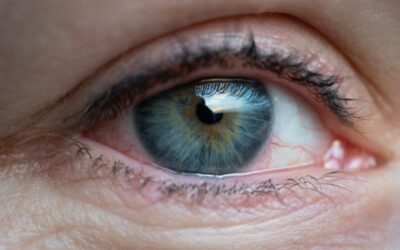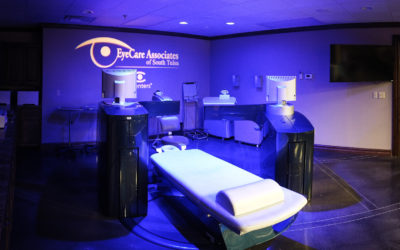NEWSLETTER
Eyes FORWARD
Cataracts – Part 1: Choosing When To Proceed With Surgery
Volume 03
“To drop, or not to drop: that is the question.” In recent years, “Dropless” cataract surgery (intracameral injection) has gained in popularity… and for very good reason. When you weigh out the Pros and Cons, the Pros are significant enough to get your attention. Conversely, the Cons against it are few, and in the grand scheme, they are all reasonably insignificant.
In the first few days following the procedure, Dropless patients don’t see as well as what we are historically accustomed to because they are looking through the injected drug that is suspended in the anterior vitreous. This is a short-term effect that lasts for a few days. Dropless patients will typically report more floaters and visual disturbances in the first few days (compared to non-Dropless patients), but when you properly counsel them regarding why we recommend Dropless, rarely is this a problem. Patients get it, especially when you stress that it is safer… and that (IMHO), is the most important thing. As I always say to patients about to undergo any type of ocular surgery… “Safety should always 0utweigh convenience”. We all want what is best for our patients, both in the short-term and in the long-term, but a patient’s long-term safety is the most important thing to me. If two things are equal, then I am comfortable with convenience driving the decision. In this case, they are not equal and Dropless is arguably the safer option. Allow me to explain this clinical opinion…
The “Three C’s” of Dropless Cataract Surgery
Here is how I like to break this down for patients about to undergo cataract surgery. When considering intracameral injection (versus traditional drops), it is important to think about:
- Cost
- Compliance
- Complications
Cost
This math is pretty simple: the cost of an intracameral injection is definitely cheaper than the combined cost of the individual bottles of antibiotic, steroid and NSAID. Now that we have compounding pharmacies like Imprimus, where we can get the antibiotic, steroid and NSAID combined in a single bottle, we see a reduction in the cost gap between the combined drop and the intracameral injection. So from purely a cost standpoint, combined drops or intracameral injection are the 2 best (least expensive) options.
Compliance
Many doctors (myself included) would admit that a non-compliant patient is one of their biggest frustrations. How do you get a patient through a crisis when they won’t follow your instructions? Studies have shown repeatedly that, more often than not, patients do not use medications as directed. They miss the target, touch the bottle tip and contaminate the bottle, lose the medications, willfully stop taking them, etc. While I believe most patients set out to be compliant, even the patients with the best intentions have a hard time following instructions, especially as dosing frequency increases and multiple drops comprise the regimen. As the dosing frequency decreases, compliance goes up. As the number of medications is reduced, compliance goes up. These facts significantly sway me over to the Dropless side of the fence. Compliance problems are eliminated because the drug is injected into the eye and works around the clock. They say piece of mind is priceless, so when you combine the fact the injectable medication is reasonably priced and it also takes the non-compliance factor out of the equation, this makes the decision very simple for me, not to mention the chair time saved by not having to discuss and reiterate what drops to use and how often.
Complications
Research has shown endophthalmitis rates in the range of 0.04% to 0.2% after cataract surgery. Studies that compare topical drops to intracameral injection consistently show a significant decrease in the risk of post-operative endophthalmitis. I have seen studies showing numbers ranging from a 5-fold decrease up to a 22-fold decrease by switching to injectable medications vs. external drops. Ask any cataract surgeon what their greatest post-operative fear is and I guarantee you that almost all would say endophthalmitis. [Note: Seeing a small subconjunctival hemorrhage at the superior temporal incision site is not uncommon and definitely a benign finding.]
As you can see, the Pros of intracameral injections grossly outweigh the Cons. At EyeCare Associates of South Tulsa, we co-manage a significant number of patients, so we believe that having open and honest dialogue with you, our referring doctors, is critical to our mutual success. We want you to know that we care for not only the safety and well-being of your patients, but we also want to build strong, relationships with you based on trust and integrity. Please lean on us. Ask us anything at any time. Call me personally. My cell number is listed below. I welcome your calls. Always know that we are here for you and when you refer to EyeCare Associates, you are referring to the best!
Until next time!
George Goodman, OD, FAAO
Director of Cataract and Refractive Services
EyeCare Associates of South Tulsa
10010 E 81st St #100, Tulsa, OK 74133
O: 918.250.2020 | C: 405-245-9333 | F: 918.250.8910
www.southtulsaeye.com
Service-oriented, comprehensive eye care in a timely fashion.
Please send your comments and suggestions to DrGoodman@southtulsaeye.com
or call Dr. Goodman at (405) 245-9333 (cell).
Missed a newsletter? Find them below.
Can Dry Eye Cause Blurry Vision?
Dry eyes are often caused by an imbalance in the tear film on the surface of the eye. This causes irritation that leads to inflammation and damage to the cornea. The most common symptom is blurred vision. Other symptoms include burning, itching, redness, and...
Implantable Collamer Lenses (ICLs) – 08
NEWSLETTER Eyes FORWARD Implantable Collamer Lenses (ICL) Volume 08 We hope that you’re enjoying our newsletters. In this edition we are going to discuss Implantable Collamer Lenses (ICLs). An ICL is a posterior chamber phakic intraocular lens (pIOL). To be more...
Refractive Lens Exchange (RLE) – 07
NEWSLETTER Eyes FORWARD Refractive Lens Exchange (RLE) Volume 07 “A rose by any other name would smell as sweet.” Thank you Mr. Shakespeare! Speaking of names, “Refractive Lens Exchange” is known by numerous monikers. Let’s see… (1) Clear Lensectomy, (2) Refractive...
Contact Lens De-adaptation – 06
NEWSLETTER Eyes FORWARD Contact Lens De-adaptation Volume 06 Thank you for the support and welcome back! In this newsletter, we are focusing our attention on contact lens de-adaptation. While this may not sound very interesting, I promise you it is… and it is vitally...
Eyes Forward – Laser Floater Treatment – Technology Matters – 05
NEWSLETTER Eyes FORWARD Laser Floater Treatment – Technology Matters Volume 05 Welcome back! We are all very excited about this second edition of Eyes Forward where we get to talk about Laser Floater Treatment (LFT). LFT, also known as Laser Vitreolysis, is a...
Eyes Forward – Laser Vision Correction – Technology Matters – 04
NEWSLETTER Eyes FORWARD Laser Vision Correction: Technology Matters! Volume 04 In this First Edition of our newly minted newsletter, we will focus on Laser Vision Correction (LVC) and discuss the best technology available… and more importantly… why it is the best. As...



